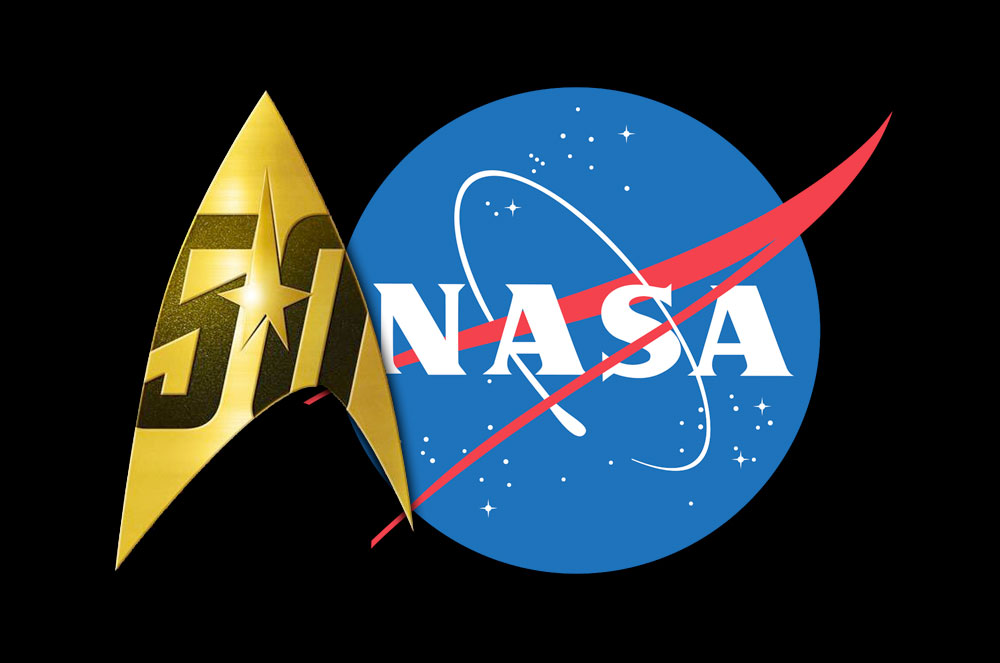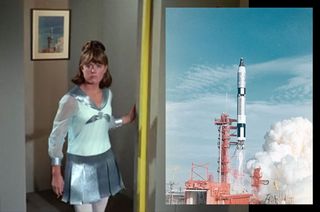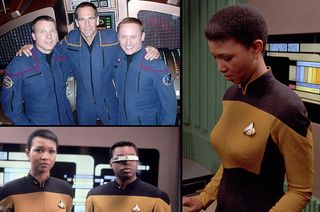'Star Trek' and NASA: 50 Years of Fictional and Factual Space Crossovers

On the evening of Sept. 8, 1966, as Americans sat down to watch the first episode of a new science fiction television series, NASA was making its final preparations to launch its ninth two-man trek into "the final frontier."
The Gemini 11 mission, with Charles Conrad and Richard Gordon at the helm, was just over 12 hours from lifting off when "Star Trek" premiered on NBC. And like the opening of "The Man Trap" — and the 78 episodes of the original series of "Star Trek" that followed it, the astronauts were set to "boldly go" almost twice as far into space than any "man had gone before."
As history had it, the Gemini 11 launch was delayed a few days due technical issues. Conrad and Gordon finally lifted off on Sept. 12, 1966, on a three-day mission to "seek out" an unmanned rendezvous target and "explore" the vacuum of space during two extravehicular activities (spacewalks). ['Star Trek' & NASA: A Science Fiction/Fact Mind-Meld in Pictures]
Audiences that tuned into "Star Trek" were presented with a future that built off the real spaceflight endeavors of the space program. Later series and movies in the "Star Trek" franchise would more explicitly draw on that connection — even including real NASA spacecraft and milestones in the fictional universe of the Starship Enterprise.
The crossovers extended the other way, too. As "Star Trek" embedded itself into pop culture, its influence expanded to NASA, its astronauts and missions.
To mark the show's 50th anniversary, here is a look at some of the times that "Star Trek" found its way into real space history, and vice versa.
First contact(s)
One of, if not the first reference to NASA that aired in "Star Trek" was a nod to the Gemini program.
Get the Space.com Newsletter
Breaking space news, the latest updates on rocket launches, skywatching events and more!
Two minutes into "Court Martial," the 20th episode of the original series, a framed photo of a rocket is seen hanging on a wall inside Starbase 11. The photo shows the launch of Gemini 6 atop a Titan II booster from Complex 19 at the Cape Canaveral Air Force Station in Florida on Dec. 15, 1965.
The episode, which first aired on Feb. 2, 1967, is set 302 years after Gemini 6, on Stardate 2947.3. Starbase 11, as shown in "Court Martial," has other images from Gemini, including a photo taken prior to the first successful docking between two spacecraft — Gemini 8 and an Agena target — by astronauts Neil Armstrong and David Scott.
(Other NASA spacecraft images appeared in the first pilot for "Star Trek," titled "The Cage," but it was not aired in its entirety until 1988. Portions of "The Cage" were broadcast in the two-part "The Menagerie," which aired in November 1966, but they did not include the real space references.)
The first, or at least one of the early, overt mentions of a NASA space mission came in "Return to Tomorrow," which aired on Feb. 9, 1968.
At one point in the episode, Captain Kirk (William Shatner) remarks, "Do you wish that the first Apollo mission hadn't reached the moon, or that we hadn't gone on to Mars and then to the nearest star?"
Of note, the moon, along with Mars and Alpha Centauri, was still in the future at the time. The first manned mission to reach the moon, Apollo 8, did not launch until December 1968, 10 months after the episode aired.
For its part, NASA's first tribute to "Star Trek" came 10 years and nine days after the TV series premiered.
On Sept. 17, 1976, NASA rolled out its first space shuttle orbiter at a ceremony in Palmdale, California. The winged spacecraft had been intended to be named "Constitution," in honor of the United States' bicentennial, but in response to a write-in campaign by "Star Trek" fans, President Gerald Ford agreed to christen it for the show's fictional starship, the "Enterprise."
Series creator Gene Roddenberry joined actors DeForest Kelley (McCoy), James Doohan (Scotty), Nichelle Nichols (Uhura), George Takei (Sulu), Leonard Nimoy (Spock) and Walter Koenig (Chekov) as guests at the unveiling.
"We were invited to the rollout of the Enterprise shuttle. I didn't have an understanding of how significant it was until we got there," said Koenig in a History Channel interview. "For the first time, I realized that there was a significance beyond the fact that we were a television show that went on once a week [and] that we really had an influence in the culture. I guess it was the first time I really felt that I could take a bow." [Final Voyage of Space Shuttle Enterprise (Photos)]

Trading spaces
In the original TV show, and in the series and movies that followed it, all but a few of the hundreds, if not thousands of people seen on the screen were pretending to be space explorers.
In what might be the definitive crossover between NASA and "Star Trek" over the past 50 years, three real astronauts traded their NASA flight suits for Starfleet uniforms.
Mike Fincke and Terry Virts, who during their careers have both lived and worked on the International Space Station, appeared on "Star Trek: Enterprise" in the episode "These Are the Voyages..." which aired in May 2005.
"There's always been a link between science fiction and science fact," said Fincke in a NASA release at the time. "Science fiction, in general, has inspired not just astronauts but all humans by giving form to our dreams to explore."
The first astronaut to appear on the Starship Enterprise did so in a 1993 episode of "Star Trek: The Next Generation."
Mae Jemison, who a year earlier became the first African-American woman in space as a crew member aboard the shuttle Endeavour, appeared as Lieutenant Palmer in the episode "Second Chances." A fan of "Star Trek" (she started her daily shifts in orbit by radioing down to Earth, "Hailing frequencies open!"), Jemison was invited to appear on the show by actor LeVar Burton, after he learned of her being inspired by Nichelle Nichols as a young girl.
Though no "Star Trek" actors have yet to make it into space for real, Nichols has flown aboard a NASA mission, joining educators in September 2015 for a flight on SOFIA, or the Stratospheric Observatory for Infrared Astronomy. Nichols boarded, rather than beamed aboard, the modified Boeing 747 jumbo jet.
"Flying on board SOFIA has many parallels to the Starship Enterprise," she said. "We went where no man or woman has gone before, and I think that's what SOFIA gives us — a tool to study where we want to go in the future."
Nichols, who in the late 1970s worked with NASA to recruit women and minorities for the first group of space shuttle-era astronaut candidates, is not the only Star Trek veteran to contribute to the space program. Both William Shatner and the late Leonard Nimoy added their voices to NASA's outreach efforts, narrating documentaries and speaking in support of the agency's exploration efforts. ['On-Going Mission' - 'Star Trek' Alumni and Astronauts Explain (Video)]

Mirror universes
In the original series "Star Trek" episode "Mirror, Mirror," a transporter malfunction revealed the existence of a parallel universe, an alternate reality where history had played out differently from our own.
In some ways, "Star Trek" has offered a similar, skewed look at NASA's past. For example, in the movie "Star Trek: The Motion Picture," before the actual space agency launched Voyager 1 and 2 on a tour of the solar system, it deployed Voyager 6, a similar-looking spacecraft to the two in reality.
Whereas Pioneer 10, which was launched in March 1972, appears in "Star Trek V: The Motion Picture" straying into Klingon territory 270 years from now. In reality, Pioneer 10, having been the first probe to fly beyond the orbits of our solar system's planets, continues today on a slow journey out into interstellar space, heading in the general direction of the red star Aldebaran in the constellation Taurus.
In some cases, it is still to be seen if NASA's missions will match those shown in "Star Trek." In the "Next Generation" episode "The Royale," it is learned that the space agency launched astronaut Stephen Richey aboard the Charybdis, a future shuttle, on July 23, 2037.
Not only did Richey wear a patch based on the design of the real Apollo 17 mission, but his spacecraft displayed the NASA "worm" logo, which was officially retired in 1992.
The crossovers between universes took place behind the scenes, too. The graphic designer credited with the look of the computer displays aboard the Enterprise for "The Next Generation," Michael Okuda, also designed the patch for NASA's STS-125 last shuttle mission to service the Hubble Space Telescope and the program logo for Orion, NASA's next generation exploration spacecraft.
See how NASA congratulated "Star Trek" on 50 years at collectSPACE.com.
Follow collectSPACE.com on Facebook and on Twitter at @collectSPACE. Copyright 2016 collectSPACE.com. All rights reserved.
Join our Space Forums to keep talking space on the latest missions, night sky and more! And if you have a news tip, correction or comment, let us know at: community@space.com.

Robert Pearlman is a space historian, journalist and the founder and editor of collectSPACE.com, a daily news publication and community devoted to space history with a particular focus on how and where space exploration intersects with pop culture. Pearlman is also a contributing writer for Space.com and co-author of "Space Stations: The Art, Science, and Reality of Working in Space” published by Smithsonian Books in 2018.In 2009, he was inducted into the U.S. Space Camp Hall of Fame in Huntsville, Alabama. In 2021, he was honored by the American Astronautical Society with the Ordway Award for Sustained Excellence in Spaceflight History. In 2023, the National Space Club Florida Committee recognized Pearlman with the Kolcum News and Communications Award for excellence in telling the space story along the Space Coast and throughout the world.
